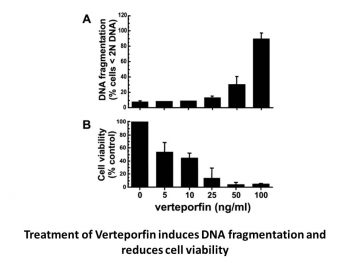This product is for research use only, not for human use. We do not sell to patients.

| Size | Price | Stock |
|---|---|---|
| 250mg | $1350 | In Stock |
| 500mg | $2120 | In Stock |
| 1g | $3180 | In Stock |
Cat #: V0682 CAS #: 129497-78-5 Purity ≥ 96%
Description: Verteporfin (also known as DB00460, CL318952, BPD-MA, BpdMA, Benzoporphyrin derivative monoacid ring A or BPD-MA) is a novel and potent second-generation photosensitizing agent derived from porphyrin in endothelial cells. It can be used for angiographic visualization of choroidal vessels and CNV.
Publications Citing InvivoChem Products
Product Promise

- Physicochemical and Storage Information
- Protocol
- Related Biological Data
- Stock Solution Preparation
- Quality Control Documentation
| Molecular Weight (MW) | 718.79 |
|---|---|
| Molecular Formula | C41H42N4O8 |
| CAS No. | 129497-78-5 |
| Storage | -20℃ for 3 years in powder formr |
| -80℃ for 2 years in solvent | |
| Solubility In Vitro | DMSO: 100 mg/mL (139.1 mM)r |
| Water: <1 mg/mLr | |
| Ethanol: <1 mg/mL | |
| SMILES Code | O=C(O)CCC1=C(C)C(/C=C2C(C=C)=C(C)/C(N/2)=C/3)=N/C1=C\C(N4)=C(CCC(OC)=O)C(C)=C4/C=C5[C@]6(C)[C@H](C(OC)=O)C(C(OC)=O)=CC=C6C3=N/5 |
| Synonyms | Verteporfin; CL 318952; BPD MA; DB 00460; CL 318952; DB-00460; CL318952; DB00460; BPD-MA; BpdMA; Benzoporphyrin D; Benzoporphyrin derivative monoacid ring A; Visudyne |
| Protocol | In Vitro | In vitro activity: Verteporfin is about four times more efficient in absorbing light at wavelengths that penetrate tissues best (i.e., around 700 nm) and thus provides a much higher cytotoxic effect than hematoporphyrin (10 times more in human adherent cell lines). Verteporfin is lipophilic and is more readily taken up by malignant or activated cells, compared with normal or resting cells. Verteporfin binds with LDL to form a complex, which is then taken up into proliferating cells (e.g., neovascular endothelial cells) probably via LDL receptors and endocytosis. Verteporfin therapy achieves complete angiographic occlusion of the neovascular compartment by thrombosis of vascular channels, following selective endothelial damage. Verteporfin therapy selectively induces reproducible and isolated choriocapillary occlusion without alteration of overlying photoreceptors or ganglion cells, as shown by light and electron microscopy. Verteporfin conbined with light rapidly exhibits apoptotic changes reflected by caspase-3 and caspase-9 activation and PARP cleavage in HL-60 cells, changes that are blocked by the general caspase inhibitor ZVAD.fmk. Cell Assay: PDX cells co-cultured with S17 cells are treated with 16 combinations of verteporfin (60 nM, 120 nM, 180 nM, and 240 nM) and dasatinib (12 nM, 24 nM, 36 nM, and 48 nM). The viabilities of cells treated with each combination are measured after 48 h using FACS Aria flow cytometer. In order to estimate drug interaction between verteporfin and dasatinib, a normalized isobologram and fraction affectedcombination index (CI) plot are made using CompuSyn software. CI values greater than 1.0 indicated antagonistic effects, equal to 1.0 additive effects, and below 1.0 synergistic effects. |
|---|---|---|
| In Vivo | Verteporfin can be used for angiographic visualization of choroidal vessels and CNV, which demonstrates that the photosensitizer accumulates rapidly in experimental CNV in monkeys. Verteporfin accumulates rapidly in the established vasculature of the choroid, RPE, and photoreceptors of rabbit eyes. Verteporfin reaches maximal tissue levels within 3 hours of intravenous injection, followed by a rapid decline within 24 hours in mice. Verteporfin is metabolized to a less active form in vivo and is cleared very rapidly, predominantly in the feces and a very small proportion excreted in urine. Verteporfin therapy effectively and selectively prevents fluorescein dye leakage from experimentally induced CNV in monkeys. | |
| Animal model | Mice: PhLO cells (1.0×107/mouse) are injected intravenously into 6-week-old male NOG mice, which are then treated with vehicle, verteporfin (140 mg/kg/day), dasatinib (20 mg/kg/day), and a combination of these drugs from days 22 to 28. Verteporfin is administered by continuous subcutaneous infusion (c.s.c.) using Alzet osmotic pumps. An intraperitoneal injection (i.p.) is performed for dasatinib. All mice are sacrificed on day 28 and the chimerism of leukemia cells is investigated by flow cytometer using an anti-human CD19 antibody and antimouse CD45 antibody. Blood concentrations of verteporfin are calculated by LCMS-2020. | |
| Dosages | IC50: YAP-TEAD interaction |
| Solvent volume to be added | Mass (the weight of a compound) | |||
|---|---|---|---|---|
| Mother liquor concentration | 1mg | 5mg | 10mg | 20mg |
| 1mM | 1.3912 mL | 6.9561 mL | 13.9123 mL | 27.8245 mL |
| 5mM | 0.2782 mL | 1.3912 mL | 2.7825 mL | 5.5649 mL |
| 10mM | 0.1391 mL | 0.6956 mL | 1.3912 mL | 2.7825 mL |
| 20mM | 0.0696 mL | 0.3478 mL | 0.6956 mL | 1.3912 mL |
This equation is commonly abbreviated as: C1 V1 = C2 V2
- (1) Please be sure that the solution is clear before the addition of next solvent. Dissolution methods like vortex, ultrasound or warming and heat may be used to aid dissolving.
- (2) Be sure to add the solvent(s) in order.






































